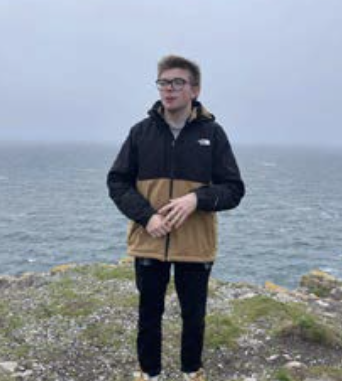
Sea-salt filled the air as my group of fellow American travelers and I stepped off a crowded ferry boat onto a creaky, metal dock. After a slightly rocky journey across Galway Bay, which saw a cloudy day turn into a dark, misty night, we had finally arrived upon the biggest of the Aran Islands, Inishmore, Ireland. My initial impressions were somewhat hampered; in the murky blackness of nighttime, only a few buildings were visible under the yellow glow of the streetlights. A few of these lamps lined a curvy road that drifted off into the scantly visible village of Kilronan. Not a single person was in sight. Along this road, a thin, granite staircase tucked against a wall led us up to Kilronan Hostel.
After an extended period of finding rooms, putting luggage away, and settling in, our group made the trek up to Tí Joe Watty’s, one of two pubs in the village of Kilronan, for a bite to eat. The terrain throughout Inishmore is uneven and rocky just as the nearest mainland landscape of the Burren is. Besides the occasional streetlamp, a wide array of brightly colored stars that make up the sky are the village’s only other light source.
At the top of a hill is a large white building where an angled, brown roof comes into view, Tí Joe Watty’s. Painted images of a violin and the Guinness toucan sitting beside a pint lets one know exactly what they’re in for within the walls of this establishment. Black-and-white photographs of local fishermen, paintings of waves crashing against sandy shores, and colorful, old beer ads fill the walls. Catching our first sight of locals, we heard them stir curiously upon the sight of this large group of newcomers, with one informing another that “this lot is studying at a school in Dublin, but they’re from the States!” It most certainly must have been an odd scene from the perspective of a native Aran Islander, who usually only sees visitors during the sunny summer months, not a dark, late winter night.
Following a cheery waiter towards the corner of the establishment, I made eyes with Dermot Morgan as Father Ted on a poster advertising the “Friends of Ted Festival ‘07” and sat with a group of friends in the corner. Over a pint of Guinness, hearty vegetable soup, and a fresh plateful of chips and the day’s catch, myself and friends Shay, Jake, and Mason discussed our seemingly instant transportation into a Synge production. The bar filled up even further, old and young alike, and many conversations in both English and Irish were occurring by the time we were ready to visit the bar top for drinks.
A small, elderly local curiously approached our group. He wore a loose-fitting black beanie and a black, knitted Aran sweater with a blue vest pulled over it. A patron who had been sitting beside him later informed us that he was 88 years old, a former fisherman, and had witnessed the first flushable toilet on the island. Introducing himself in a thick accent as Padraic, he asked myself and several of my companions where we were from. Everywhere from Pennsylvania to South Carolina to Minnesota were described to Padraic as he listened in wonder. His next question he delivered with an air of importance. “And are you Irish?” Our group looked at one another. From experiences elsewhere in Ireland, particularly Dublin, we had quickly learned that the American tendency to proudly proclaim one’s distant Irish heritage was looked down upon. Accordingly, the group was somewhat reluctant to do so in front of Padraic but obliged anyway in a modest manner.
“I can see it in your faces!” the old man responded giddily. Padraic’s warm welcome broke any shyness our group had in conversing with the locals of Inishmore, as both local and tourist alike were quick to join one another in conversation. Friends entered and left and eventually music continued, but the conversation between me and Padraic continued.
Amidst the liveliness of the bar, Padraic took a hold of my arm and whispered in my ear, “Ná bris na rútaí.” I looked back at Padraic, waiting for his translation. “It means ‘Don’t break the roots’” he stated. “Your people left but now you’re back!” Padraic’s excitement upon meeting this group with even the faintest connection to his homeland was infectious. Through our conversation, it became obvious that the Irish language was second nature to the old man, with another bar patron explaining to me that he was “the best Irish speaker on the islands.” Throughout the rest of my night at the bar, Padraic repeatedly grabbed my arm and had me say that same line to him: “Ná bris na rútaí.” Nearly every time I did so, Padraic raised his hands and laughed excitedly, never tiring of hearing those four Irish words. At one point, he even stated, “You’ll soon be speaking it fluently!”
Sean McGinley: semcginley@ursinus.edu
